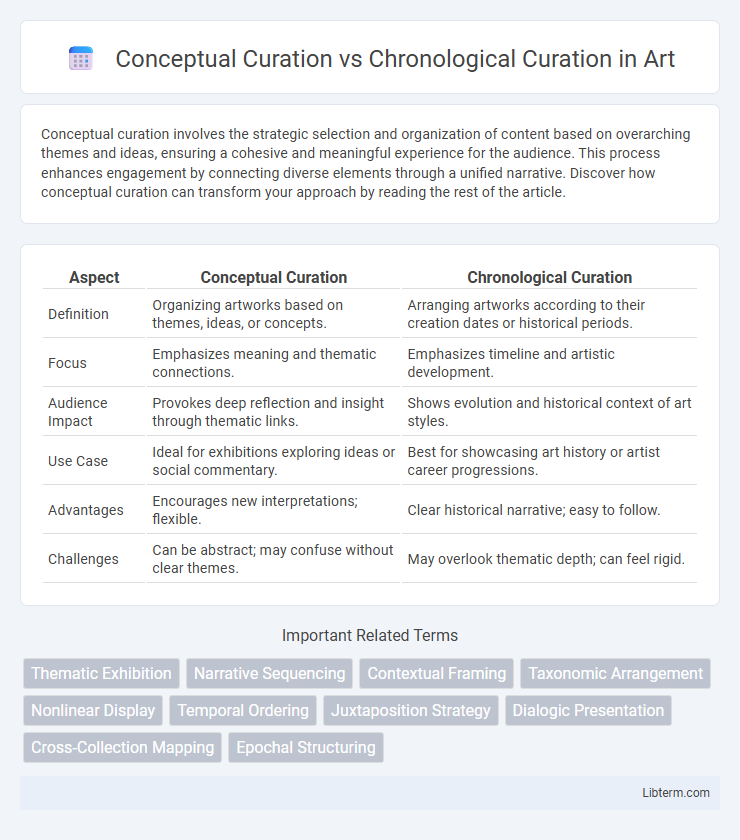Conceptual curation involves the strategic selection and organization of content based on overarching themes and ideas, ensuring a cohesive and meaningful experience for the audience. This process enhances engagement by connecting diverse elements through a unified narrative. Discover how conceptual curation can transform your approach by reading the rest of the article.
Table of Comparison
| Aspect | Conceptual Curation | Chronological Curation |
|---|---|---|
| Definition | Organizing artworks based on themes, ideas, or concepts. | Arranging artworks according to their creation dates or historical periods. |
| Focus | Emphasizes meaning and thematic connections. | Emphasizes timeline and artistic development. |
| Audience Impact | Provokes deep reflection and insight through thematic links. | Shows evolution and historical context of art styles. |
| Use Case | Ideal for exhibitions exploring ideas or social commentary. | Best for showcasing art history or artist career progressions. |
| Advantages | Encourages new interpretations; flexible. | Clear historical narrative; easy to follow. |
| Challenges | Can be abstract; may confuse without clear themes. | May overlook thematic depth; can feel rigid. |
Understanding Curation: Conceptual vs Chronological
Conceptual curation organizes content based on themes, ideas, or subjects, enabling deeper exploration of related concepts and fostering meaningful connections for the audience. Chronological curation arranges content according to a timeline, highlighting the evolution and progression of events or works, which aids in understanding historical context and development. Choosing between these methods depends on whether the goal is to emphasize thematic relationships or temporal sequencing in content presentation.
Defining Conceptual Curation
Conceptual curation organizes content based on themes, ideas, or narratives, enabling deeper connections between individual pieces beyond their timeline. It prioritizes meaning and context over sequence, making the collection resonate through shared concepts or messages. This method contrasts with chronological curation, which arranges items strictly according to their creation dates, emphasizing historical progression.
What is Chronological Curation?
Chronological curation organizes content or artifacts based on their sequence in time, emphasizing historical progression and temporal context. This method allows audiences to understand developments, trends, and changes as they occurred, providing a clear timeline of events or creations. Museums, archives, and digital platforms often employ chronological curation to illustrate evolution within a specific subject or collection.
Key Differences Between Conceptual and Chronological Curation
Conceptual curation organizes content based on themes, ideas, or subject matter, allowing for a deeper exploration of related concepts regardless of time period. Chronological curation arranges items sequentially by date, emphasizing the progression and historical context over time. Key differences include the focus on thematic connection in conceptual curation versus the temporal sequence in chronological curation, impacting how audiences interpret and engage with the curated material.
Advantages of Conceptual Curation
Conceptual curation enhances thematic coherence by organizing content based on ideas, enabling deeper exploration and stronger narrative connections across diverse works. It promotes audience engagement through meaningful interpretation and invites critical thinking by grouping artifacts according to shared concepts rather than time periods. This approach offers flexibility in exhibition design, allowing curators to tailor experiences that resonate emotionally and intellectually beyond linear historical constraints.
Benefits of Chronological Curation
Chronological curation organizes content or artifacts based on their temporal sequence, providing a clear timeline that enhances understanding of historical progression and contextual relationships. It allows audiences to trace the development, evolution, and impact of ideas, events, or artworks in a linear and logical manner. This method improves engagement by delivering a structured narrative that highlights cause-and-effect connections and cultural shifts over specific periods.
Challenges in Curating by Concept or Time
Curating by concept poses challenges such as defining abstract themes that may vary in interpretation, ensuring cohesive connections among diverse works, and maintaining audience engagement through thematic depth. Chronological curation demands accurate timeline reconstruction, overcoming gaps or ambiguities in historical data, and balancing narrative flow with contextual relevance across time periods. Both methods require meticulous research to authentically represent artistic evolution and cultural significance.
Best Use Cases for Each Curation Approach
Conceptual curation excels in thematic storytelling, ideal for exhibitions or content collections emphasizing ideas, emotions, or cultural narratives, allowing for deep, meaningful connections between disparate items. Chronological curation is best suited for historical displays or archives where understanding evolution, progress, or timelines adds clarity and context, ensuring a logical flow that highlights cause and effect. Each approach optimizes audience engagement depending on whether the focus is on conceptual depth or temporal sequence.
Integrating Conceptual and Chronological Methods
Integrating conceptual and chronological curation enhances the storytelling by combining thematic coherence with historical context, offering a multidimensional understanding of the subject. This hybrid approach facilitates deeper engagement by aligning artifacts or content with both their conceptual significance and temporal evolution. Museums and archives leveraging this integration provide audiences with a richer, more immersive experience that bridges interpretive frameworks and timelines.
Choosing the Right Curation Strategy for Your Collection
Choosing the right curation strategy depends on the goals of your collection and the audience's needs. Conceptual curation groups items by theme, idea, or subject, enhancing interpretive depth and enabling viewers to explore connections beyond time. Chronological curation presents artifacts in sequential order, emphasizing historical development and clear temporal context that aids understanding of progression and change.
Conceptual Curation Infographic

 libterm.com
libterm.com